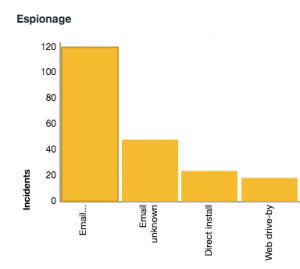As your workforce spreads across the planet, you now have to support a completely new collection of networks, apps, and endpoints. We all know that this increased attack surface area is more difficult to manage. Part of the challenge is that you have to create new standards, policies, and so forth to protect your enterprise and reduce risk as you make this transformation to become a more distributed company. In this blog post, I will examine some of the things to look out for. My thesis is that you want to match the risks with the approaches, so that you focus on the optimal security improvements as you make this transition to a distributed staffing model.
There are two broad brush items to think about: one has nothing to do with technology, and one that does. Let’s take the first item. Regardless of what technologies we deploy, the way we choose them is really critical. Your enterprise doesn’t have to be very large before you have different stakeholders and decision-makers that are influencing what gets bought and when. This isn’t exclusively a technology decision per se – but it has huge security and risk implications. If
You buy the wrong gear, you don’t do yourself any favors and can increase your corporate risk profile rather than reduce it. The last thing any of us need is to have different departments with their own incompatible security tools. This different stakeholder issue is something that I spoke about in my last blog post on managing third party risk.
Why is this important now? Certainly, we have had “shadow IT” departments making independent computer purchases almost since corporations first began buying PCs in the early 1980s. But unlike that era, where corporations were concerned about buying Compaqs vs. IBM, it has more serious implications and greater risk, because of the extreme connectivity that we now face in the average business. One weak link in your infrastructure, one infected Android phone, and your risk can quickly escalate.
But there is another factor in the technology choice process, and that is because getting security right is hard. It isn’t just buying something off the shelf, it is more likely you will need several items and that means you have to fit them together in the right way to provide the most protection and to address all the various vectors of compromise and risk. This makes sense, because as the attack surface area increases, we add technologies to our defensive portfolio to match and step up our game. But here’s the catch: what we choose is also as important as the way we choose them too.
Assuming you can get both of these factors under control, let’s next talk about some of the actual technology-related issues. They roughly fall into three categories: authentication/access, endpoint protection and threat detection/event management.
Authentication, identity and access rights management. Most of us immediately think about this class of problems when it comes to reducing risk, and certainly there are a boatload of tools to help us do so. For example, you might want to have a tool to enable single sign-ons, so that you can reduce password fatigue and also improve on- and off-boarding of employees. No arguments there.
But you before you go out and buy one or more of these products, you might want to understand how out of date is your Active Directory. And by this, I mean quantify the level of effort you will need to make it accurate and represent the current state of your users and network resources. The Global Risk Report from Varonis found that more than half of their customers had more than a thousand stale user accounts that weren’t removed from the books. That is a lot of housecleaning before any authentication mechanism is going to be useful. Clearly, many of us need to improve our offboarding processes to ensure that terminating access rights are done at the appropriate moment – and not six months down the road when an attacker had seized control of a terminated user with an active account.
This level of accuracy means that organizations will also have to match identity assurance mechanisms with the right levels of risk. Otherwise, you aren’t protecting the right things with the appropriate level of security. You’ll want to answer questions such as:
- Do you know where you most critical business assets are and know to protect them properly?
- How will your third-party partners and others outside your immediate employ authenticate themselves? Will they need (or should they use) a different system from your full-time staff?
- Can you audit your overall portfolio of access rights for devices and corporate computing resources to ensure they are appropriate and offer the best current context? At many firms, everyone has admin access to every network share: clearly, that is a very risky path to take.
Endpoint protection. This topic understandably gets a lot of attention, especially these days as threats are targeting vulnerabilities of specific endpoints such as Windows and Android devices. Back in the days when everyone worked next to each other in a few physical office locations, it was relatively easy to set this up and effectively screen against incoming malware. But as our corporate empire has spread around the world, it is harder to do. Many endpoint products were not designed for the kinds of latencies that are typical across wide-area links, for example. Or can’t produce warnings in near-real-time to be effective. Or can’t handle endpoints as effectively without pre-installed agents.
That is bad enough, but there is another complicating factor. That is few products do equally well at protecting mobile, PCs and endpoints running embedded systems. You often multiple products to cover your complete endpoint collection. As the malware writers are getting smarter at hiding their activities in plain sight, we must do a better job of figuring out when they have compromised an endpoint and shut them down. How these multiple products play together can introduce more risk.
Threat detection and event management. Our third challenge for the distributed workforce is being able to detect and deter abuses and attacks in a timely and efficient manner across your entire infrastructure. This is much harder, given that there is no longer any hard division between corporate-owned devices and servers and non-owned devices, including personal endpoints and cloud workloads. Remember when we used to refer to “bring your own device”? That seems so last year now: most corporations just assume that remote workers will use whatever they already have. That places a higher risk on their security teams to be able to detect and prevent threats that could originate on these devices.
The heterogeneous device portfolios of the current era also place a bigger burden – and higher risk – on watching and interpreting the various security event logs. If malware has touched any of these devices, something will appear on a log entry and this means security analysts need to have the right kinds of automated tools to alert them about any anomalies.
As I have said before, managing risk isn’t a one-and-done decision, but a continuous journey. I hope the above items will stimulate your own thinking about the various touchpoints you’ll need to consider for your own environment as you make your journey towards improving your enterprise security.
 Paul and I first met Jen McClure (left) more than a decade ago and shortly after she founded the Society for New Communications Research (SNCR) in 2005. Jen, who has been a frequent guest on Shel Holtz’s FIR main podcast, was one of the first people to see the potential of social media in business communications. SNCR merged with The Conference Board three years ago, and fortunately the awards program Jen created at SNCR has continued as The Conference Board’s Excellence in Marketing & Communications Awards. This week we discuss three outstanding winners of the awards, which will be presented in New York City on June 26th, in conjunction with The Conference Board’s 24th Annual Corporate Communications Conference. Two of our picks are B2B.
Paul and I first met Jen McClure (left) more than a decade ago and shortly after she founded the Society for New Communications Research (SNCR) in 2005. Jen, who has been a frequent guest on Shel Holtz’s FIR main podcast, was one of the first people to see the potential of social media in business communications. SNCR merged with The Conference Board three years ago, and fortunately the awards program Jen created at SNCR has continued as The Conference Board’s Excellence in Marketing & Communications Awards. This week we discuss three outstanding winners of the awards, which will be presented in New York City on June 26th, in conjunction with The Conference Board’s 24th Annual Corporate Communications Conference. Two of our picks are B2B.



 My earliest memory of the prototype
My earliest memory of the prototype  Another deep resource on nomadic tips and tricks is from Jodi Ettenberg on LegalNomads. As you might assume, she was a former corporate lawyer who took to the road back in 2008 and started writing about food. But then her lawyerly training took over and she dug deeper. She has a very
Another deep resource on nomadic tips and tricks is from Jodi Ettenberg on LegalNomads. As you might assume, she was a former corporate lawyer who took to the road back in 2008 and started writing about food. But then her lawyerly training took over and she dug deeper. She has a very  A few years ago, I came across Nikki and Jason Wynn, a 30-something couple that has been on the road since 2011. They initially sold their Dallas home and contents and bought an RV. They drove around the country for six years and then traded their RV for a sailboat. They are now somewhere in Polynesia, taking on the world.
A few years ago, I came across Nikki and Jason Wynn, a 30-something couple that has been on the road since 2011. They initially sold their Dallas home and contents and bought an RV. They drove around the country for six years and then traded their RV for a sailboat. They are now somewhere in Polynesia, taking on the world.  Let’s move on from boating to flying.
Let’s move on from boating to flying.  Mike Elgan has been writing about tech as long as I have, and now he has turned his nomadic leanings into a viable business. He and his wife Amira run
Mike Elgan has been writing about tech as long as I have, and now he has turned his nomadic leanings into a viable business. He and his wife Amira run  Paul Gillin and I are old hands at email newsletters. Paul had his own for several years and has produced several for his clients. I currently publish two:
Paul Gillin and I are old hands at email newsletters. Paul had his own for several years and has produced several for his clients. I currently publish two:  The threat of fileless malware and its potential to harm enterprises is growing. Fileless malware leverages what threat actors call “living off the land,” meaning the malware uses code that already exists on the average Windows computer. When you think about the modern Windows setup, this is a lot of code: PowerShell, Windows Management Instrumentation (WMI), Visual Basic (VB), Windows Registry keys that have actionable data, the .NET framework, etc. Malware doesn’t have to drop a file to use these programs for bad intentions.
The threat of fileless malware and its potential to harm enterprises is growing. Fileless malware leverages what threat actors call “living off the land,” meaning the malware uses code that already exists on the average Windows computer. When you think about the modern Windows setup, this is a lot of code: PowerShell, Windows Management Instrumentation (WMI), Visual Basic (VB), Windows Registry keys that have actionable data, the .NET framework, etc. Malware doesn’t have to drop a file to use these programs for bad intentions.